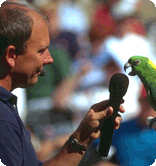Greenwing Screaming

Dear Steve, I welcomed Thor, a Green-winged macaw, into my family when he was about 6 months old. As a baby, he was docile and quiet. At around 30 months, he started to become (for lack of a better word) a real jerk. I have read a lot about parrots and their ‘terrible twos’ and expected much of this behavior. One facet that I can no longer tolerate is his screaming. His cage is in an area of the family room that adjoins our kitchen. We spend 90% of our time in these two rooms, so he is always involved in daily life.
He speaks very well for a macaw, so I used techniques on these forums to train him to use more pleasant words/sounds he already knows to express his wants. For example, while we eat dinner in the family room, if he would like to try some of what we are eating, he says “hello”. If we are out of sight and he wants to see us, he calls out, “never more”. This worked great for quite awhile, but now he has come to expect it. When he says hello a few times and doesn’t get receive food he begins to scream. I have tried switching his toys more often and making sure he has time to exercise out of his cage. It seems the more attention I give him and the more I try to work with him, the more demanding he becomes.
I am seeking any advice you can give on how to establish a mutual understanding and respect with Thor regarding food, volume, etc.
How do you teach a parrot the age-old lesson: you can’t always get what you want?
Thanks,
Alex Altomare

Hello Alex! My name is Chris Jenkins, and I am one of the Supervisors with Natural Encounters, Inc. I received your question about your screaming macaw, Thor, and I'd be happy to offer you some advice that should be helpful in dealing with it.
Screaming is a natural behavior for parrots, and is therefore a behavior that can never be eliminated completely. That being said, it is well within your ability to use positive reinforcement to train your bird to reduce the frequency and duration of these screams, and to replace them with other vocalizations that you find more acceptable.
From what you've detailed, it sounds like you've gotten some good training information that can give you a head start on working to reduce the incidence of Thor's screaming. The basic plan that we try to follow when dealing with a screaming parrot is two-fold. First, we try to make sure that we don't do anything to reinforce the screaming as it occurs. Second, we work to train the bird to perform behaviors that are incompatible with screaming in order to get what it wants. We'll tackle these two aspects one at a time.
First, it is important to not reinforce the behavior that you want to see eliminated. Parrots have the ability to call very loudly, as you have heard. What we want to make sure is that we don't inadvertently train our birds to scream in order to get what they want. Some companion owners will give their birds treats or toys when they are screaming in hopes that it will shift their focus and keep them occupied. Others will ignore their birds when they scream until it reaches an intensity that they can't tolerate, and then go to their birds to either console or scold them. Both of these scenarios send the message that screaming will earn the bird a desirable consequence. In the first case, the bird learns that it can earn a variety of treats or toys by screaming. The second case is basically the same, as the bird learns not only that it can get attention (even if it is negative attention) by screaming, but that in order for it to work they have to scream very, very loudly!
It is important, then, for the bird to learn that screaming will not earn it something that it wants. If the bird learns that there is no positive consequence to screaming, then over time the bird will spend less time and energy performing this behavior in order to achieve that outcome. Be aware, though, that a behavior that was previously reinforced and is now ignored will usually go through what is know in the training world as an "extinction burst." This means that, before giving up, the animal will likely perform the previously reinforced behavior with a higher intensity or duration than they ever have before in a last ditch effort to earn reinforcement. In Thor's case, this means that the screaming will likely get worse before it gets better. Think of it as when you are trying to call someone to get his or her attention. If a soft "Hey there" doesn't work, you say "Hey" a little louder. If that doesn't work, you say it even louder than that. If that doesn't work, you may yell "HEEEEEYYYYYY!!!" before giving up and realizing that the person isn't going to pay attention to you. Thor's screaming will likely follow the same progression, and it is vitally important that you resist the temptation to respond in any way during this "burst", as doing so sends the message to him that he can only get your attention by screaming really, really, REALLY loudly. We know of one companion parrot owner who has taken up the habit of freezing in place wherever she is in her home when her cockatoo screams, for fear that she might in some way make a movement or sound that could inadvertently reinforce the bird. That might be a bit of an extreme example, but it definitely takes to heart the importance of not reinforcing an unwanted behavior.
So must you sit idly by while your bird screams louder and louder? Not at all. At the same time that you are ignoring the unwanted behavior, you can work to train your bird to perform behaviors that you like in order for it to earn desirable consequences. From what you've said you've already been reinforcing Thor for vocalizations that you like, "Hello" and "Never more". By pairing these vocalizations with the reinforcers that you mentioned, you've strengthened them to a point that they are now offered more and more frequently. This is to be expected, as he has learned that there are desirable consequences to these particular behaviors. In order to avoid the screaming that occurs when he doesn't get these reinforcers, there are a few different strategies that you might find helpful to try. If you want to maintain the two vocalizations above, I would suggest working to slowly increase the length of time between when the vocalization occurs and when he gets reinforced for it. We've worked with a number of people who've had this exact same issue, and what seems to work well is to introduce a secondary reinforcer -- perhaps verbal praise like the word "Good" -- that happens after he vocalizes but before you give him the treat or attention. This praise, if presented consistently, will tell the bird that what it's just done was good, and that a treat or attention will follow. In the training world this is known as a "bridge" because it bridges the length of time between when the behavior occurred and when the treat is delivered. In the early stages of training you can bridge and reinforce the bird right after the behavior occurs, but the goal will be to slowly lengthen the time between the behavior and it's consequences. This is not a quick fix, and will take some time, but it is a very reliable method that has been successful for a number of companion parrot owners over the years. At first this may involve making fairly frequent trips from your chair to his cage, but with time and consistency you should be able to stretch the time between these trips out to whatever length of time you think is appropriate. Also, your response of "Good" can be a reinforcer in and of itself. If the bird vocalizes in a way you like and you answer back, this "call and response" can become an additional form of attention that Thor can learn that he will get for performing this desirable vocalizations, thus giving you another way to reinforce him without always having to get up to do so.
In addition to lengthening the amount of time between when these vocalizations occur and when reinforcement arrives, you should also train him to perform other behaviors that are incompatible with screaming. The behaviors that we suggest for this particular case would be any soft call, whistle, or vocalization that you find acceptable. The more these sounds are reinforced, the more likely your bird will be to perform them, and because you will be making sure to not reinforce unwanted vocalizations like screaming, Thor will learn that it is much more worth his while to spend his time performing the behaviors that have consequences that he likes instead of those that are ignored. At the same time, I would think about how else you might set up your environment to give Thor the best chance to be successful in the training that you'll be doing. If you find that he's most likely to scream during dinner, you might consider giving him lots of attention just prior to dinnertime, and then leaving him with some treats or a favorite toy during dinnertime. You may also consider making this his dinnertime as well, as he will likely be more occupied with what he's been given to eat at that time than with what's going on at the dinner table. If you feel that the screaming is a function of his being out of the sight of you during dinner, you can do a test and see if moving his cage so that he can see you while you eat makes a difference, as he may just be calling because he can hear people but can't see what's going on.
In summary, the best way to teach Thor that he can't always get what he wants is by making sure you provide clear, consistent communication about what the consequences of his various behaviors will be. Making sure that he gets lots of attention and reinforcement when he is performing behaviors that you like, ignoring and not reinforcing behaviors that you don't like, and actively working to replace unwanted behaviors with more desirable, incompatible ones will give Thor a new vocabulary for how he should interact with the humans that he shares him home with, and will hopefully give your ears a much needed rest.
With patience, determination, and consistency, I have no doubt that the above methods can begin to lead to a significant decline in Thor's screaming. If you haven't done so already, I'd also suggest checking out the articles we have posted at http://www.naturalencounters.com, as they contain information about bird training, behavior, and enrichment that you may find interesting and useful.
Best of luck to you both!
Sincerely,
Chris Jenkins
Supervisor
Natural Encounters, Inc.

































